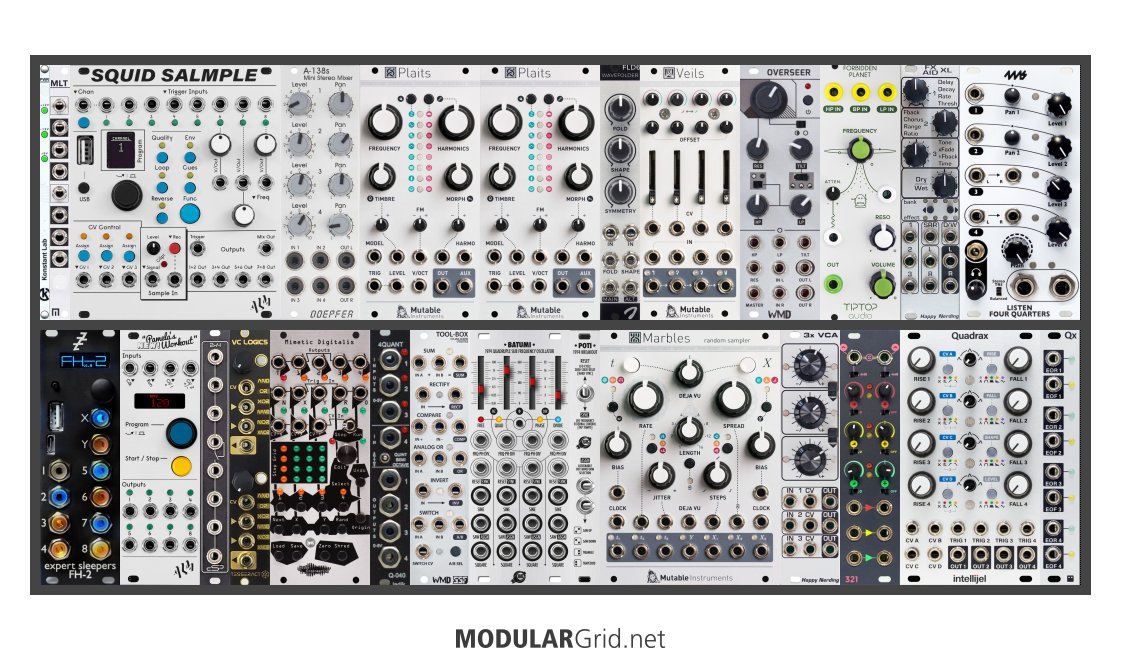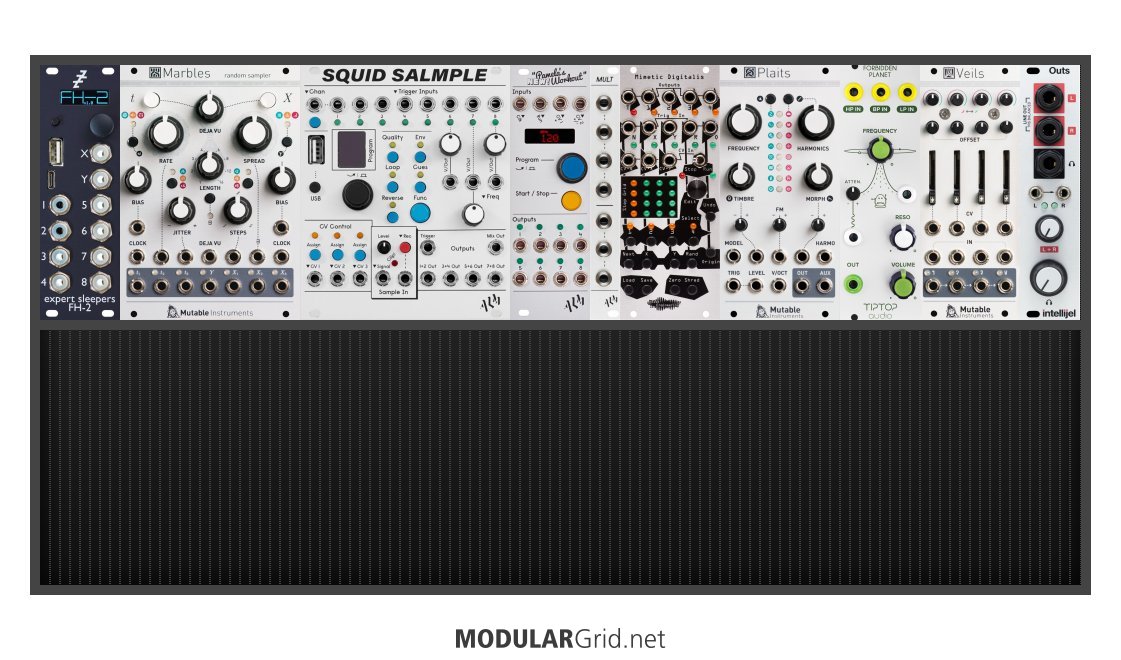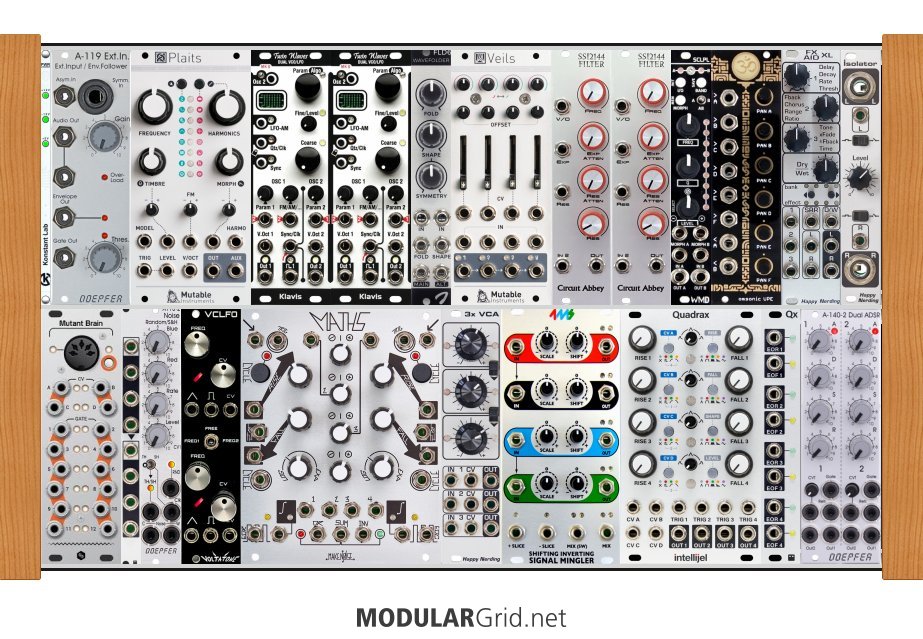Poked at it, opted to go ahead and come up with a filled cab that used your initial module selection. The only thing that didn't make the cut was the output module, and you'll see how that got fixed in a bit. Here's the build:

This was a little tricky when I was trying to make a single voicing section work...because it didn't seem suitable. Instead, there's TWO paths in the voicing section, one for the Salmple and one for the Plaits'. Here's how it works...
Top row: Konstant Labs PWRchekr to keep an eye on your DC rails. Then there's a buffered mult, because this thing actually has up to SIX pitch CV destinations, and I didn't want to risk voltage sag. I put a manual stereo mixer after this to sum the separate track outputs down to a stereo pair. After that, TWO Plaits...because while one oscillator is good, two is BETTER. With that, you can do a bunch of detunings and make the Plaits sound huge, or use one as a "voice" and the other as an audio rate FM source, which the other Plaits can have a field day with. Then a Joranalogue wavefolder...which you'll note has dual inputs, so if you wanted to smash the audio from both Plaits at the same time to create something REALLY out there, you can. Veils is next...now, here's where it gets fun.
As I noted before, this has TWO voicing paths, and here's what controls BOTH. You would send the stereo mixer's out to a pair of the VCAs for stereo control, and patch those directly to the stereo Overseer VCF's inputs. Then the last two VCAs are for mixing the Plaits...for that, you'd use two VCA inputs, but only patch to the LAST VCA in that set. So if you have the Salmple on VCAs 1 and 2, then you'd patch those VCAs individually from the Veils' mixbus. But for the two Plaits inputs, you'd use VCAs 3 and 4, but only patch up output 4 so that VCAs 3 and 4 now act as a VC mixer to sum the Plaits down to mono. Pretty cool, pretty neat!
Anyway, the Overseer is a stereo VCF, specifically there for properly filtering the Salmple's post-VCA outs. Should work fantastically with the stereo signal coming off of the Veils. And the Forbidden Planet stays, because that's your "lead line" VCF; the Steiner Synthacon VCF has a rep for being extremely "out front", something I know first-hand! That gets fed by the summed Plaits output. After that, you'll see a Happy Nerding FX Aid XL, a really capable FX-1-based stereo processor, which can be used in a number of ways, then the stereo mixer at the end is a 4ms ListenFour 1/4. Remember what I said about the Intellijel output module? This mixer HAS the 1/4" outs and a headphone preamp built-in, in addition to having two pannable channels and two stereo paired channels (usable in mono by patching only the left input).
Bottom row: FH-2, Pam's, then an unbuffered mult for gate/trig signals that need splitting for, say, the Salmple, or aspects of the Marbles, and so on. After that, there's a Tesseract VC Logics, which gives you two channels of Boolean logic with CV over gate type on each. By using this with some "contrary" gate sources (via the Pam's, for example), you can arrive at even MORE different gate patterns from just two Pam's channels on each logic gate. Mimey Digits are next (yes, I routinely rip on NE for these schoolboy Latin names), but since it has no internal quantization, I dropped in a quad UNgated chromatic quantizer to deal with that AND to provide even more scalar tesselation CV results from things such as LFOs or EGs when you send those through the quantizer.
After that, an SSF Tool Box, because...SSF Tool Box. One of the best multi-utility modules, jams a buttload of functionality into a mere 6 hp. Then, there's your LFOs courtesy of a Batumi/Poti pair. Marbles follows this, and it now has a host of things to gnaw on for random results. After that is a great pairing: Happy Nerding's 3xVCA + Frap's 321. These are for tampering with your modulation behavior, as the VCAs can control level over modulation since they're DC-coupled linear VCAs -- unlike the Veils, on which you can change the VCA topology in a continuum between linear and exponential. And the Frap is a tiny minimatrix mixer coupled with a few other CV/mod tricks. And lastly, envelopes courtesy of a Quadrax/Qx combo; these can ALSO serve as looping envelopes (ie: LFO with CV over rise and fall, rather Maths-ish). The Qx, also, allows you to implement cascading between the four AR EGs in the Quadrax, or can also be used to trigger other events elsewhere on End Of Rise or End of Fall of any of the EGs.
Yeah, this is much farther along than the original build, but it's here also as a way to see how you can exploit the various aspects of the modules that were there by adding other complementary modules. Plus, take note of the multiple capabilities that many of the modules have; in a small build like this, you NEED to think multifunctionally so that you get your functionality optimized. Using multi-function modules like the ones all over the place in this version is KEY to making a smaller build work by making the space for a single-function module work for a LOT of things besides the desired module function. Not necessarily saying to run out and grab the whole thing at one time (unless, of course, you work like that and have the requisite dumpster full of money to allow that), but this is more to show how to really blow the lid off of a build from just a handful of starting modules. Still, if you DID opt to grab it all at once, you'd have a helluva modular in your hands!







